Paleoenvironmental Evaluation Using an Integrated Microfacies Evidence and Triangle Model Diagram: A Case Study from Khurmala Formation, Northeastern Iraq
Abstract
:1. Introduction
2. Geological Setting
3. Material and Methods
4. Result
4.1. Fieldwork Observation
- The lower part, composed of thin- to medium-bedded, gray- to brown-color limestone, in places recrystallized facies are observed, filling some voids with fine cements, occasionally fragmented and non-fragmented reefal limestone associated with benthic foraminifera intercalated, with thin-bedded sandy limestone also recognized. The dominant reef component is represented by calcareous red algae and coral forms. The former is followed by a thin- to medium-bedded, dolomitic marly limestone with dolomitic limestone containing red and green algae, plus red algae, echinoids, and bivalves.
- The middle part is exposed to a higher degree of recrystallization than the lower part, partly dolomitized, fossiliferous limestone rich in calcareous red algae, and a foraminiferal biocomponent.
- The upper part is thin to medium, well-bedded, and highly recrystallized compared to the middle and lower parts; dolomitic rock is ubiquitous; and fossiliferous limestone is less common than in other parts of the recent sequence.
4.2. Microfacies
4.2.1. Coralligenous–Algal Wackestone (Figure 4a,b)
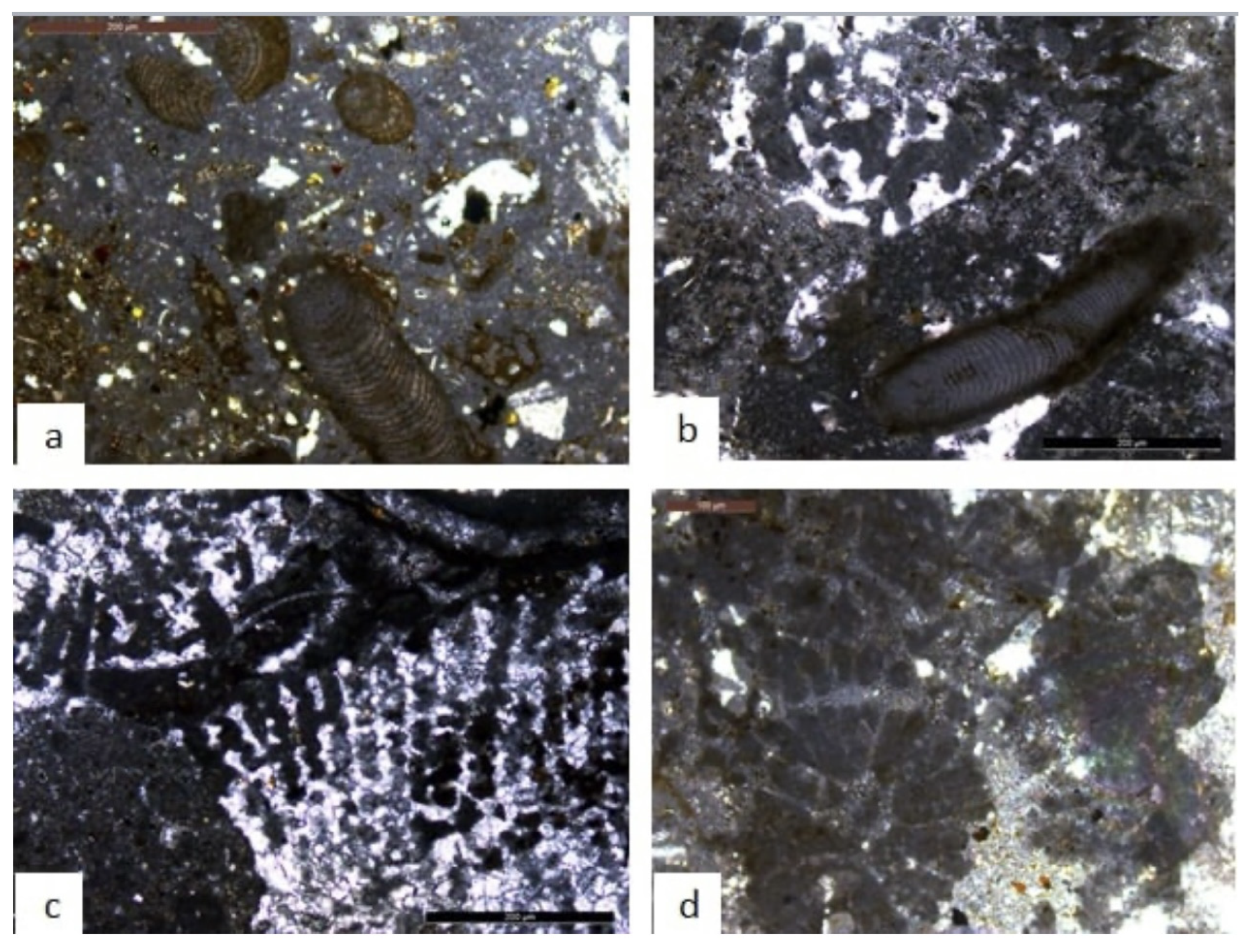
4.2.2. Foraminiferal–Peloidal Packstone (Figure 4c,d)
4.2.3. Foraminiferal–Peloidal Grainstone (Figure 5)
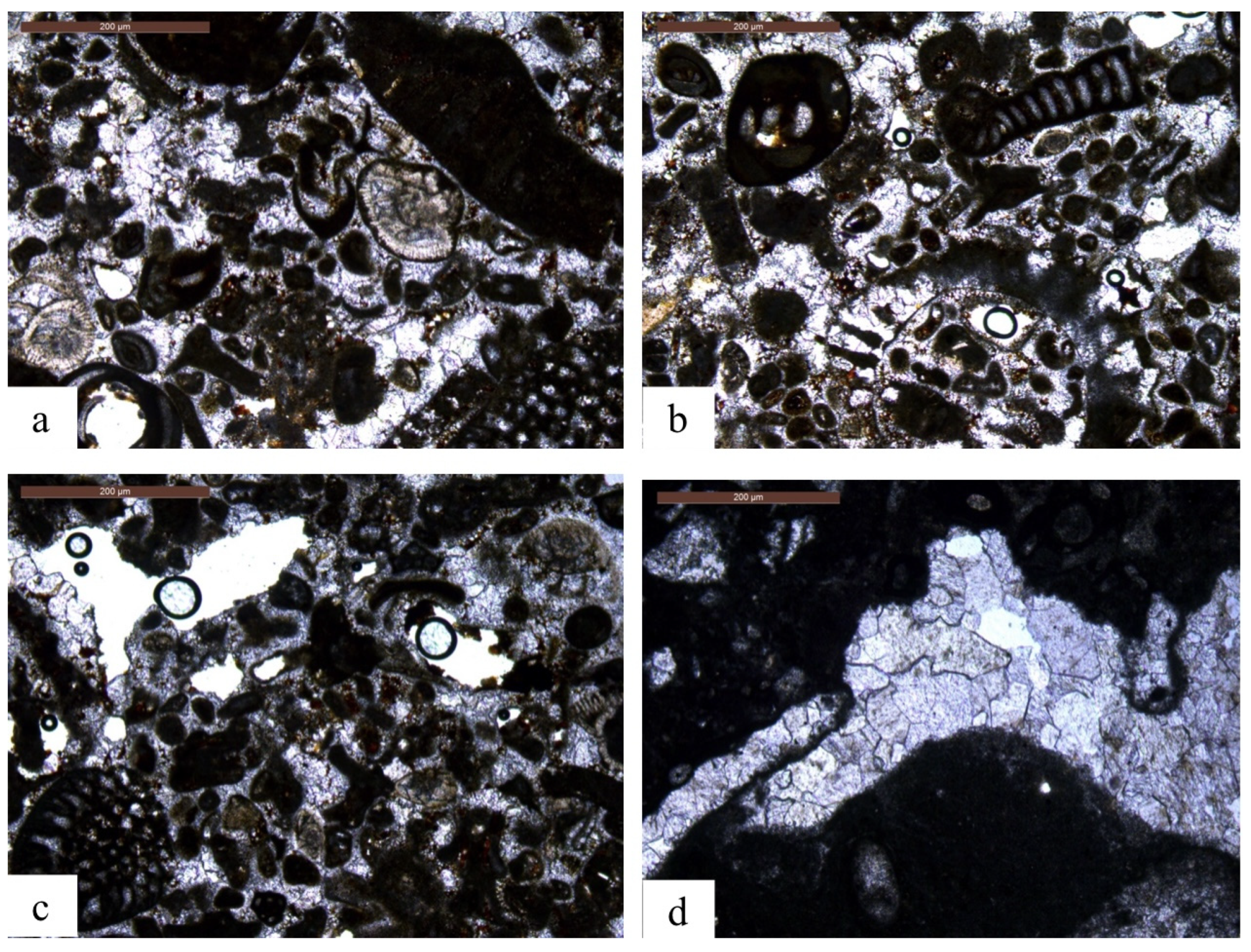
4.3. Triangle Model Diagram and Standard Facies Zone
5. Discussion
6. Conclusions
- The Khurmala Formation consists mostly of thin- to medium-bedded, fossiliferous, partly recrystallized limestone.
- Diverse benthic foraminiferal and agal bio-components were identified using optical observation, showing abundant dasycladacean green algae, calcareous geniculate red algae, and benthic foraminifera.
- Three main microfacies types were recognized: (i) coralligenous–algal wackestone, (ii) foraminiferal–peloidal packstone, and (iii) foraminiferal–peloidal grainstone. New findings of dasycladacean green algae, Acicularia and Clypeina, together with abundant geniculate red algae, suggest an open-platform environment setting.
- The abrupt and discontinuous changes in microfossil and microfacies belts indicate a change in relative sea level during the Paleocene–Eocene cycle, marked by rapid and significant climatic disturbances during this interval.
- Foraminiferal–peloidal grainstone shifted toward the open platform; in this case, washing of mud needs high water energy, leading to transport of the grains along wider areas. Consequently, all these reasons are related to environmental conditions due to the sea level fluctuations that affected appearance, lifestyle of organisms, and depositional textures of the facies.
- Using a triangle model diagram, this study postulated that most of the Khurmala Formation deposited in shallow marine environments—both open-platform and semi-restricted back-reef environments.
- Shallow-water, high-energy water conditions indicated that bio-components populated the lower-left part of triangle diagram faunas, denoting an open energetic, back-reef environment (FZ 7).
- The bio-assemblages of protected environments populated the lower right, where most of the bio-components of wackestone facies were included, and finer-grain bounded material denoted the protected environment (FZ 8). The appearance of Acicularia in wackestone floating in fine-grain micritic components indicated low-turbulence lagoonal environmental conditions.
Author Contributions
Funding
Institutional Review Board Statement
Informed Consent Statement
Data Availability Statement
Conflicts of Interest
References
- Jassim, S.Z.; Goff, J.C. Geology of Iraq, 1st ed.; Dolin: Prague, Czech Republic; Moravian Museum: Brno, Czech Republic, 2006. [Google Scholar]
- Al-Qayim, B.; Omar, A.; Koyi, H. Tectonostratigraphy overview of the Zagros Suture Zone, Kurdistan Region, Northeast Iraq, Geoarabia, Petrolink, Bahrain. GeoArabia 2012, 17, 109–156. [Google Scholar] [CrossRef]
- Sharland, P.R.; Archer, R.; Casey, D.M.; Davies, R.B.; Hall, S.H.; Heward, A.P.; Horbury, A.D.; Simmons, M.D. Arabian Plate Sequence Stratigraphy; Special Publication 2. Gulf Petro Link; GeoArabia: Bahrain, Pakistan, 2001. [Google Scholar]
- Martyushev, D.A.; Chalova, P.O.; Davoodi, S.; Ashraf, U. Evaluation of facies heterogeneity in reef carbonate reservoirs: A case study from the oil field, Perm Krai, Central-Eastern Russia. Geoenergy Sci. Eng. 2023, 227, 211814. [Google Scholar] [CrossRef]
- Hallock, P.; Glenn, E.C. Larger foraminifera: A tools of palaeoenvironmental analysis for Cenozoic depositional carbonate facies. Palaios 1986, 1, 55–64. [Google Scholar] [CrossRef]
- Dunham, R.H. Classification of carbonate rocks according to depositional texture. In Classification of Carbonate Rocks; W.E. Ham, Ed.; American Association of Petroleum Geologists: Tulsa, OK, USA, 1962; pp. 108–121. [Google Scholar]
- Embry, A.F.; Klovan, J.E. Absolute water depth limits of late Devonian paleoecological zones. Geol. Rundsch. 1972, 61, 672–686. [Google Scholar] [CrossRef]
- Sousa, S.H.M.; Yamashita, C.; Semensatto, D.L., Jr.; Santarosa, A.C.A.; Iwai, F.S.; Omachi, C.Y.; Disaró, S.T.; Martins, M.V.A.; Barbosa, C.F.; Bonetti, C.H.C.; et al. Members of the BIOFOM group. Opportunities and challenges in incorporating benthic foraminifera in marine and coastal environmental biomonitoring of soft sediments: From science to regulation and practice. J. Sediment. Environ. 2020, 5, 267–275. [Google Scholar] [CrossRef]
- Romano, E.; Bergamin, L.; Parise, M. Benthic Foraminifera as Environmental Indicators in Mediterranean Marine Caves: A Review. Geosciences 2022, 12, 42. [Google Scholar] [CrossRef]
- Zeppilli, D.; Leduc, D.; Fontanier, C.; Fontaneto, D.; Fuchs, S.; Gooday, A.J.; Goineau, A.; Ingels, J.; Ivanenko, V.N.; Møbjerg Kristensen, R.; et al. Characteristics of meiofauna in extreme marine ecosystems: A review. Mar. Biodiv. 2018, 48, 35–71. [Google Scholar] [CrossRef]
- Martyushev, D.A.; Zaytsev, R.A. Influence of oilfield reef carbonate reservoir petrophysical parameters of tournasian-famennian deposits in Upper Kama on well productivity. Bull. Tomsk. Polytech. Univ. Geo Assets Eng. 2019, 330, 77–85. [Google Scholar] [CrossRef]
- Avnaim-Katav, S.; Almogi-Labin, A.; Sandler, A.; Sivan, D. Benthic foraminifera as palaeoenvironmental indicators during the last million years in the eastern Mediterranean inner shelf. Palaeogeogr. Palaeoclimatol. Palaeoecol. 2013, 386, 512–530. [Google Scholar] [CrossRef]
- Makarian, E.; Abad, A.B.M.N.; Manaman, N.S.; Mansourian, D.; Elyasi, A.; Namazifard, P.; Martyushev, D. An efficient and comprehensive poroelastic analysis of hydrocarbon systems using multiple data sets through laboratory tests and geophysical logs: A case study in an iranian hydrocarbon reservoir. Carbonates Evaporites 2023, 38, 37. [Google Scholar] [CrossRef]
- Flugel, E. Microfacies of Carbonate Rocks, Analysis, Interpretation and Application; Springer: Berlin/Heidelberg, Germany, 2010; p. 976. [Google Scholar]
- Martyushev, D.A.; Ponomareva, I.N.; Chukhlov, A.S.; Davoodi, S.; Osovetsky, B.M.; Kazymov, K.P.; Yang, Y. Study of void space structure and its influence on carbonate reservoir properties: X-ray microtomography, electron microscopy, and well testing. Mar. Pet. Geol. 2023, 151, 106192. [Google Scholar] [CrossRef]
- Wilson, J.L. Carbonate Facies in Geologic History; Springer: New York, NY, USA, 1975; 471p. [Google Scholar] [CrossRef]
- Salih, N.; Préat, A.; Gerdes, A.; Konhauser, K.; Proust, J.-N. Tracking the Origin and Evolution of Diagenetic Fluids of Upper Jurassic Carbonate Rocks in the Zagros Thrust Fold Belt, NE-Iraq. Water 2021, 13, 3284. [Google Scholar] [CrossRef]
- Salih, N.; Mansurbeg, H.; Préat, A. Geochemical and Dynamic Model of Repeated Hydrothermal Injections in Two Mesozoic Successions, Provençal Domain, Maritime Alps, SE-France. Minerals 2020, 10, 775. [Google Scholar] [CrossRef]
- Kamal, I.; Salih, N.M.; Martyushev, D.A. Correlations between Petroleum Reservoir Fluid Properties and Amount of Evolved and Dissolved Natural Gas: Case Study of Transgressive–Regressive-Sequence Sedimentary Rocks. J. Mar. Sci. Eng. 2023, 11, 1891. [Google Scholar] [CrossRef]
- Corriero, G.; Pierri, C.; Mercurio, M.; Nonnis Marzano, C.; Onen Tarantini, S.; Gravina, M.F.; Lisco, S.; Moretti, M.; De Giosa, F.; Valenzano, E.; et al. A Mediterranean mesophotic coral reef built by non-symbiotic scleractinians. Sci. Rep. 2019, 9, 3601. [Google Scholar] [CrossRef] [PubMed]
- Cardone, F.; Corriero, G.; Longo, C.; Pierri, C.; Gimenez, G.; Gravina, M.F.; Giangrande, A.; Lisco, S.; Moretti, M.; De Giosa, F.; et al. A system of marine animal bioconstructions in the mesophotic zone along the Southeastern Italian coast. Front. Mar. Sci. 2022, 9, 948836. [Google Scholar] [CrossRef]
- Abu Shama, A.M.; Wanas, S.A. El-Nahrawy. Calcareous Nannofossil Biostratigraphy of the Paleocene-Lower Eocene Successions in the Farafra Oasis, Western Desert, Egypt. J. Afr. Earth Sci. 2019, 150, 466–484. [Google Scholar] [CrossRef]
- Farouk, S.; Lawa, F.A.; Abdeldaim, A.; Mohammed, I.Q.; Al-Khatany, K. Astronomical time scale of the lower Miocene depositional sequences (Aquitanian-Burdigalian) in the Jambour Field, northern Iraq. Mar. Pet. Geol. 2023, 151, 106182. [Google Scholar] [CrossRef]
- Korobova, N.I.; Shevchuk, N.S.; Karnyushina, E.E.; Sautkin, R.S.; Krasnova, E.A. Composition and structure features of the Vikulov productive deposits (Krasnoleninsky arch) and their influence on reservoir properties. Georesursy 2023, 25, 105–122. [Google Scholar] [CrossRef]
- Indrupskiy, I.M.; Ibragimov, I.I.; Tsagan-Mandzhiev, T.N.; Lutfullin, A.A.; Chirkunov, A.P.; Shakirov, R.I.; Alekseeva, Y.V. Laboratory, numerical and field assessment of the effectiveness of cyclic geomechanical treatment on a tournaisian carbonate reservoir. J. Min. Inst. 2023, 262, 581–593. [Google Scholar] [CrossRef]
- Dong, S.-Q.; Zhong, Z.-H.; Cui, X.-H.; Zeng, L.-B.; Yang, X.; Liu, J.-J.; Sun, Y.-M.; Hao, J.-R. A deep kernel method for lithofacies identification using conventional well logs. Pet. Sci. 2023, 20, 1411–1428. [Google Scholar] [CrossRef]
- Dar, Q.U.Z.; Renhai, P.; Ghazi, S.; Ahmed, S.; Ali, R.I.; Mehmood, M. Depositional facies and reservoir characteristics of the Early Cretaceous Lower Goru Formation, Lower Indus Basin Pakistan: Integration of petrographic and gamma-ray log analysis. Petroleum 2023, 9, 331–341. [Google Scholar] [CrossRef]
- Luu Thi Phuong, L.B.; Ellwood, B.; Nguyen Khac, S.; Hsung Wang, W.; Doan Dinh, L.; Nguyen Thanh, D.; Nguyen Thi, M. High-resolution record of Paleoclimate during the late Quarternary, recovered from Con Moong cave-North Vietnam. Vietnam. J. Earth Sci. 2023, 45, 374–387. [Google Scholar] [CrossRef] [PubMed]
- Shan, X.; Mu, H.; Liu, Y.; Li, R.; Zhu, J.; Shi, Y.; Leng, Q.; Yi, J. Subaqueous volcanic eruptive facies, facies model and its reservoir significance in a continental lacustrine basin: A case from the Cretaceous in Chaganhua area of southern Songliao Basin, NE China. Pet. Explor. Dev. 2023, 50, 826–839. [Google Scholar] [CrossRef]
- Hassan, A.R.; Radwan, A.; Mahfouz, K.H.; Leila, M. Sedimentary facies analysis, seismic interpretation, and reservoir rock typing of the syn-rift Middle Jurassic reservoirs in Meleiha concession, north Western Desert, Egypt. J. Petrol. Explor. Prod. Technol. 2023, 13, 2171–2195. [Google Scholar] [CrossRef]
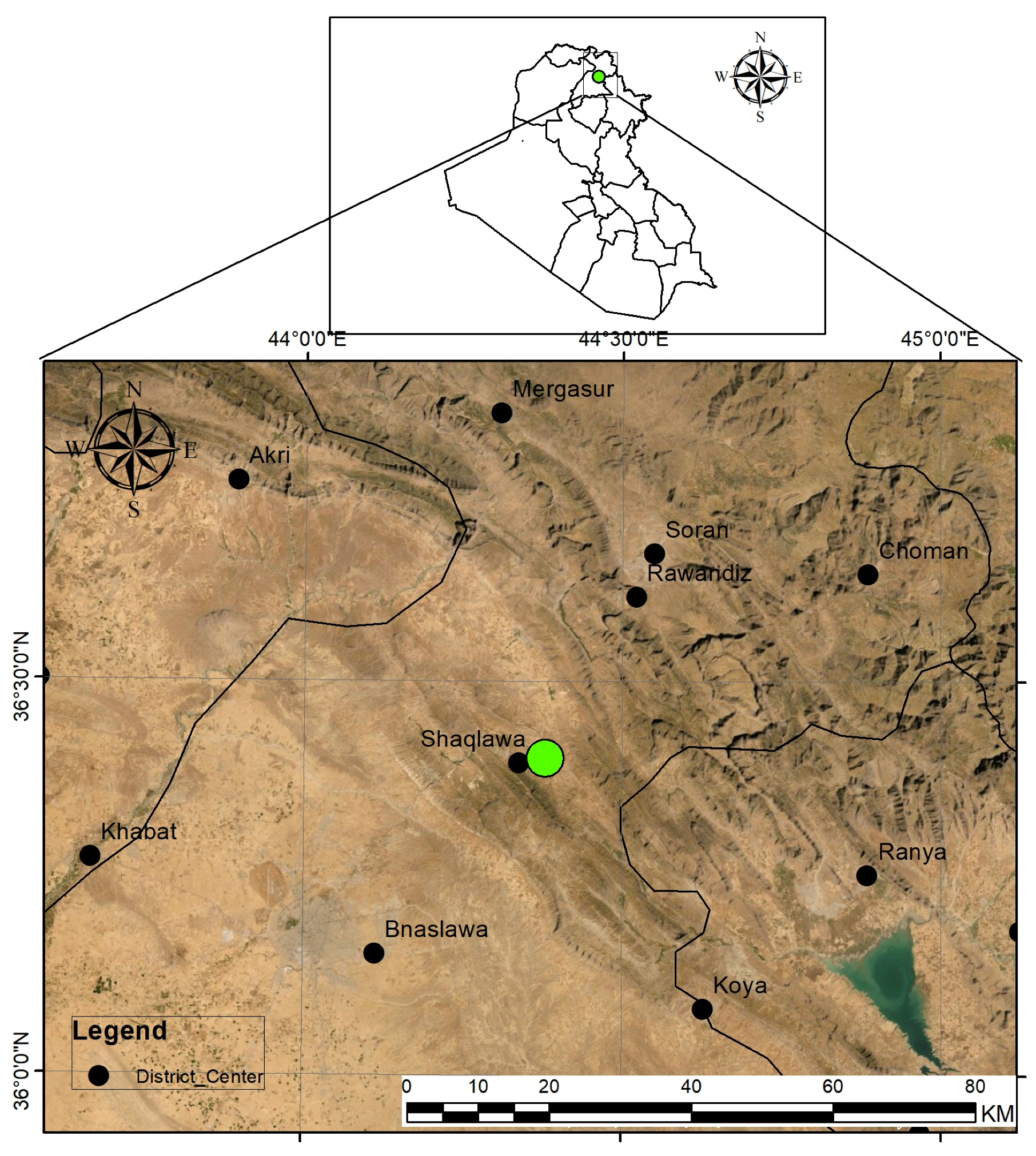
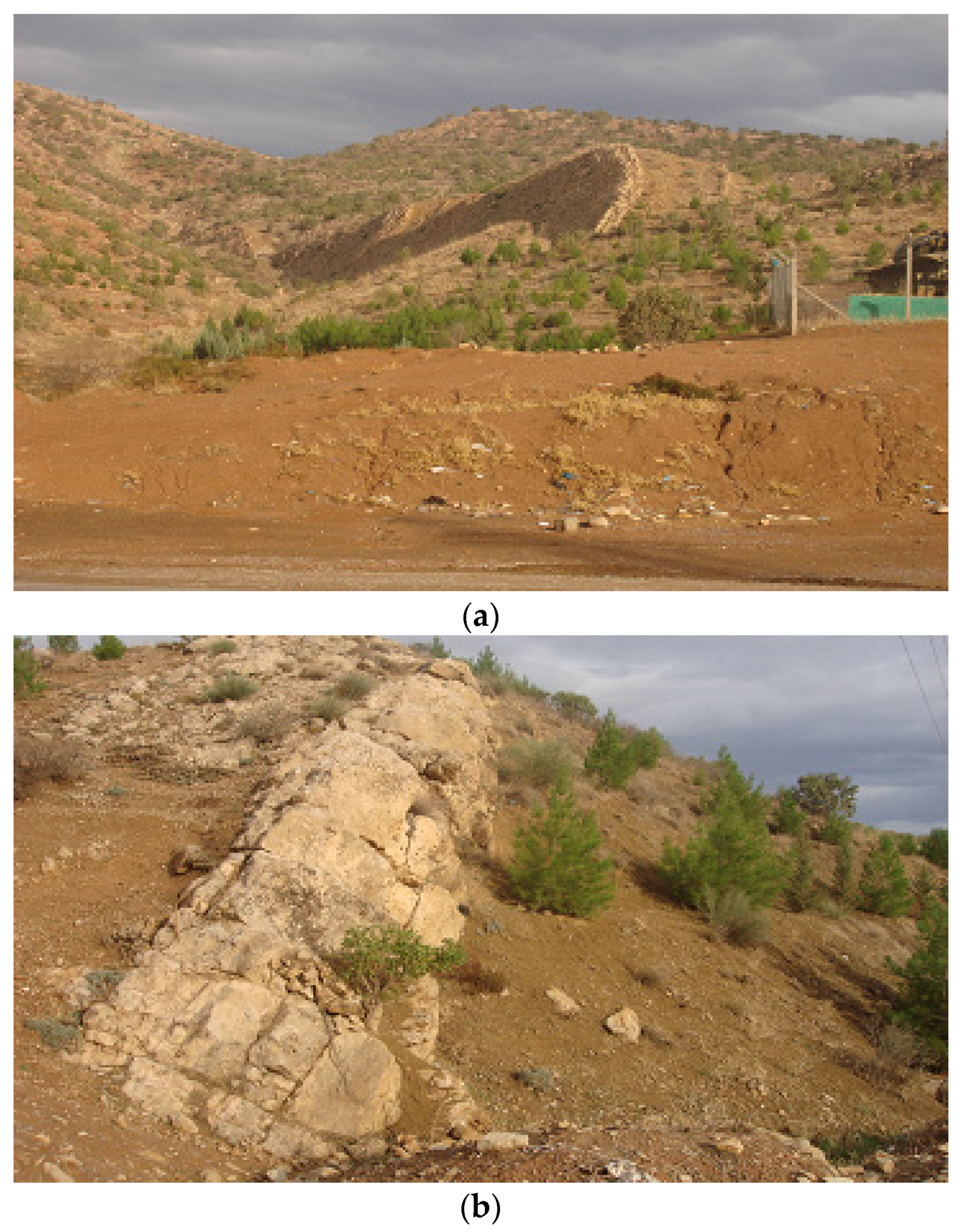
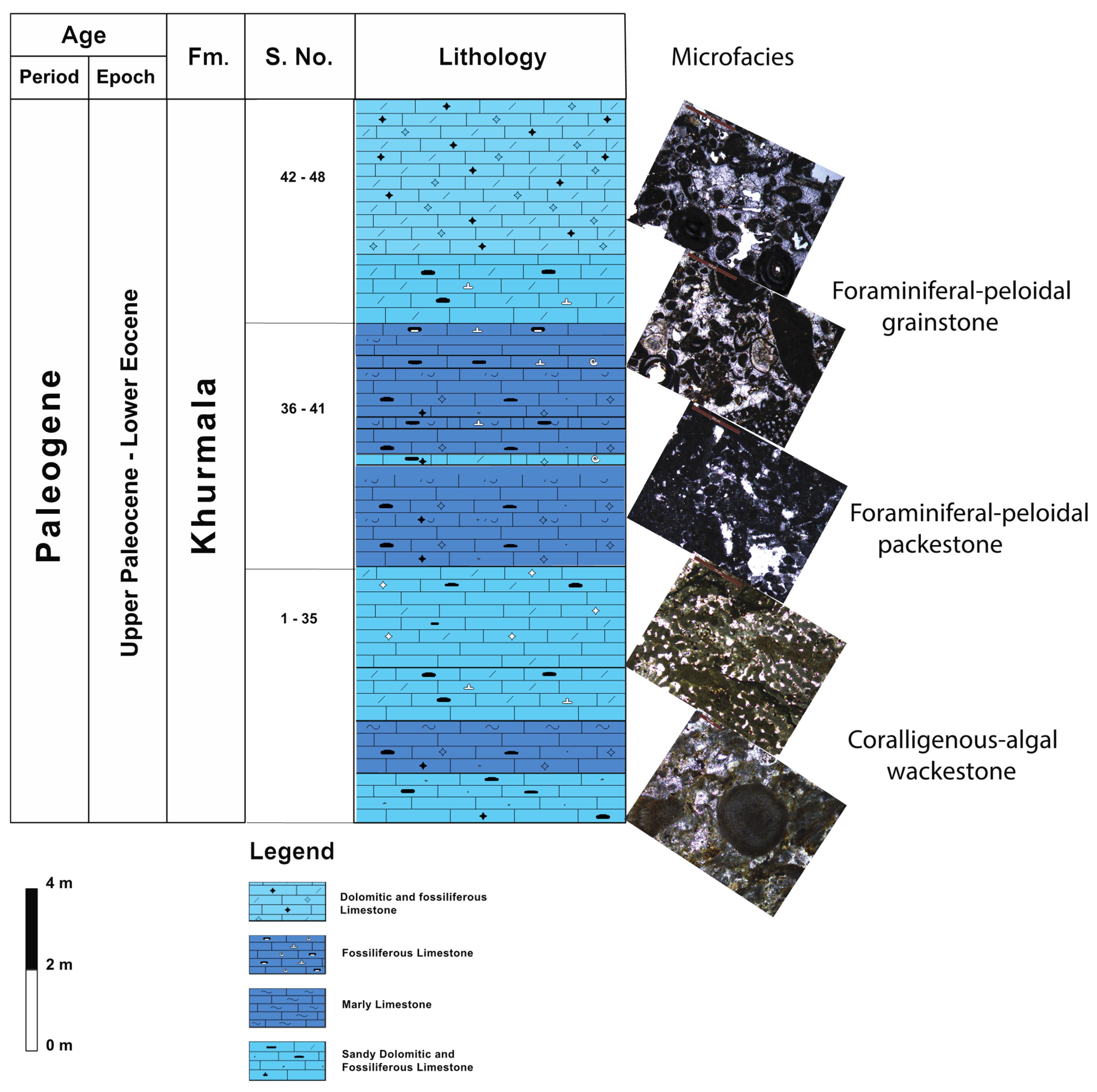
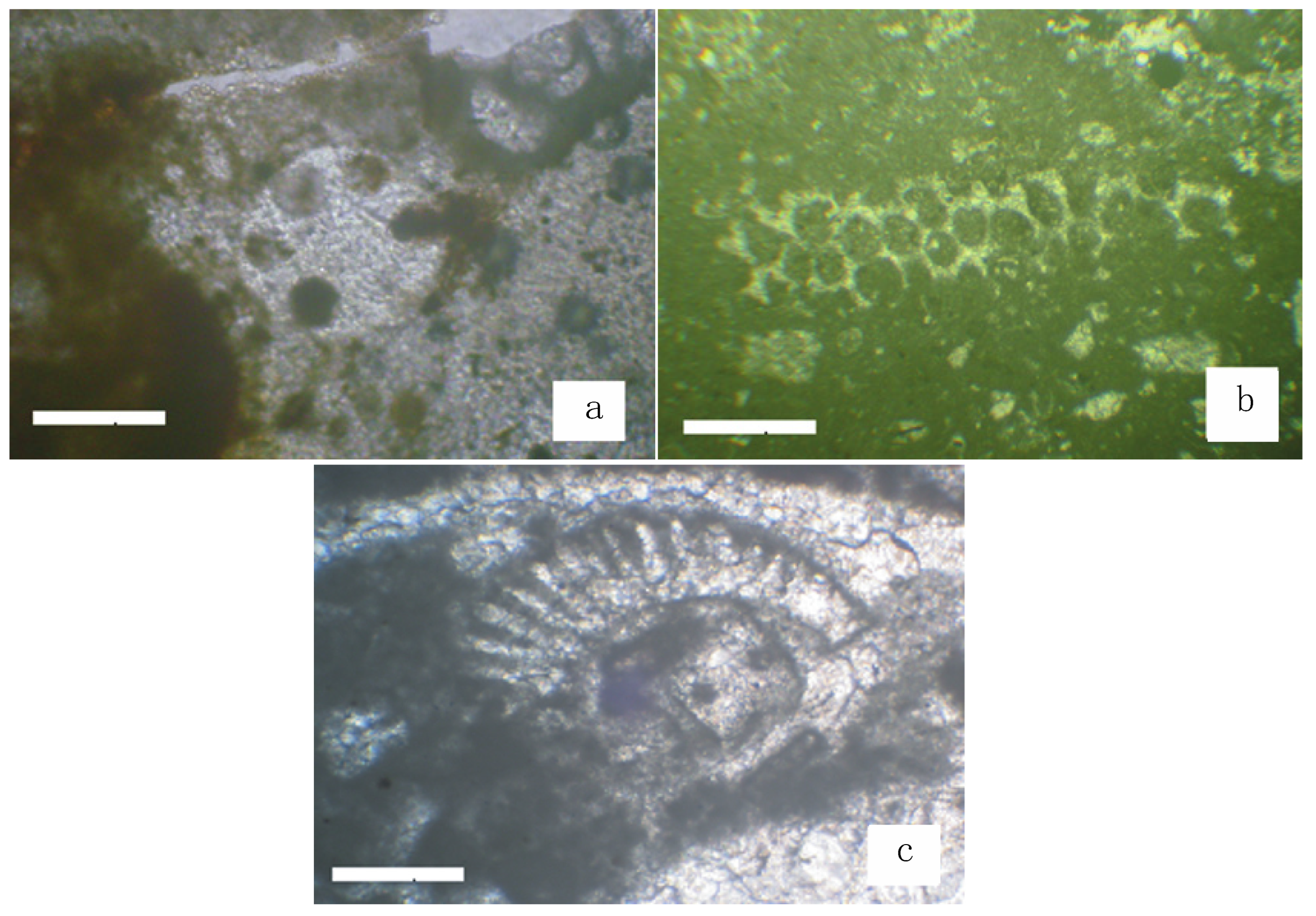
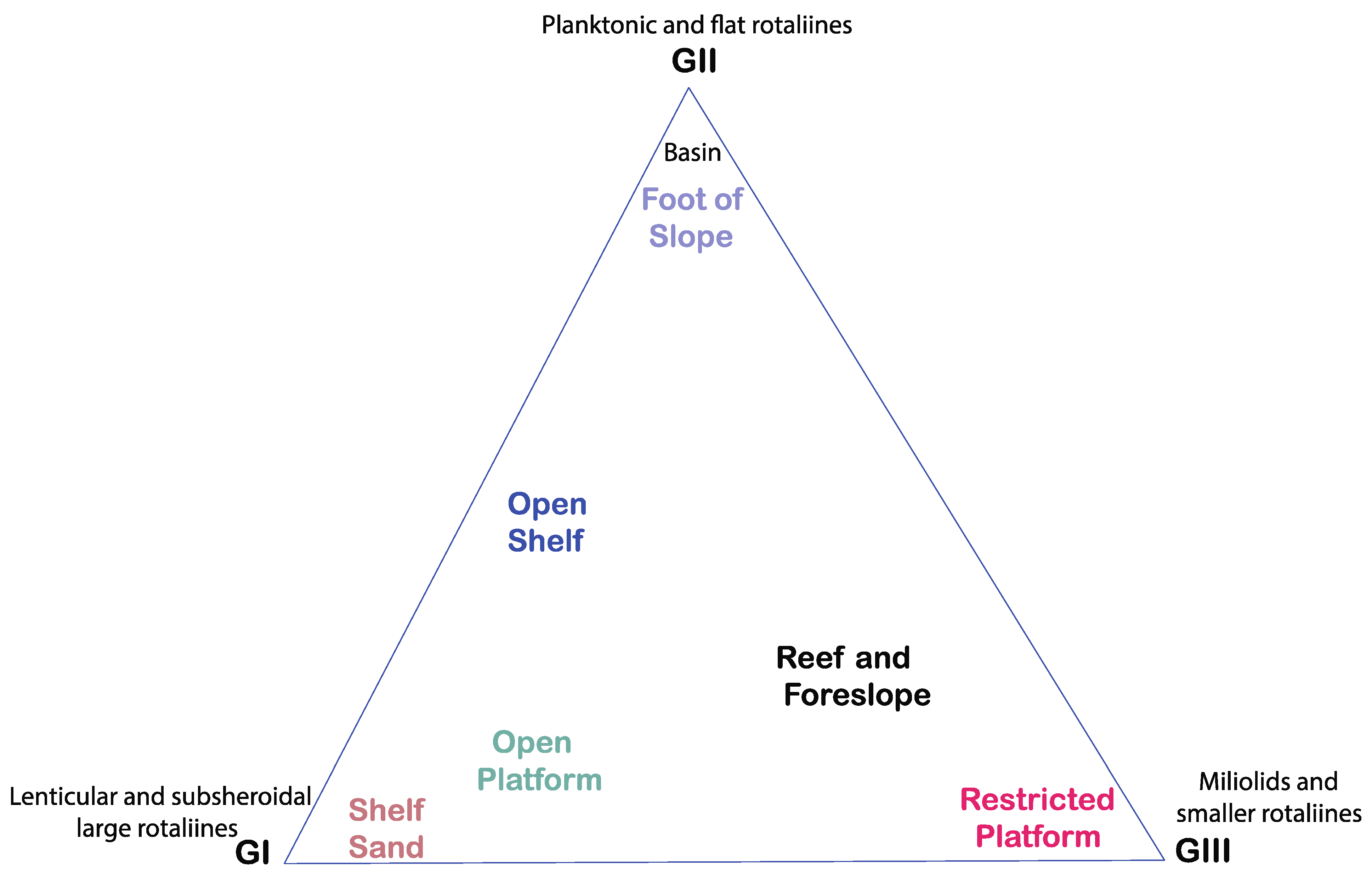
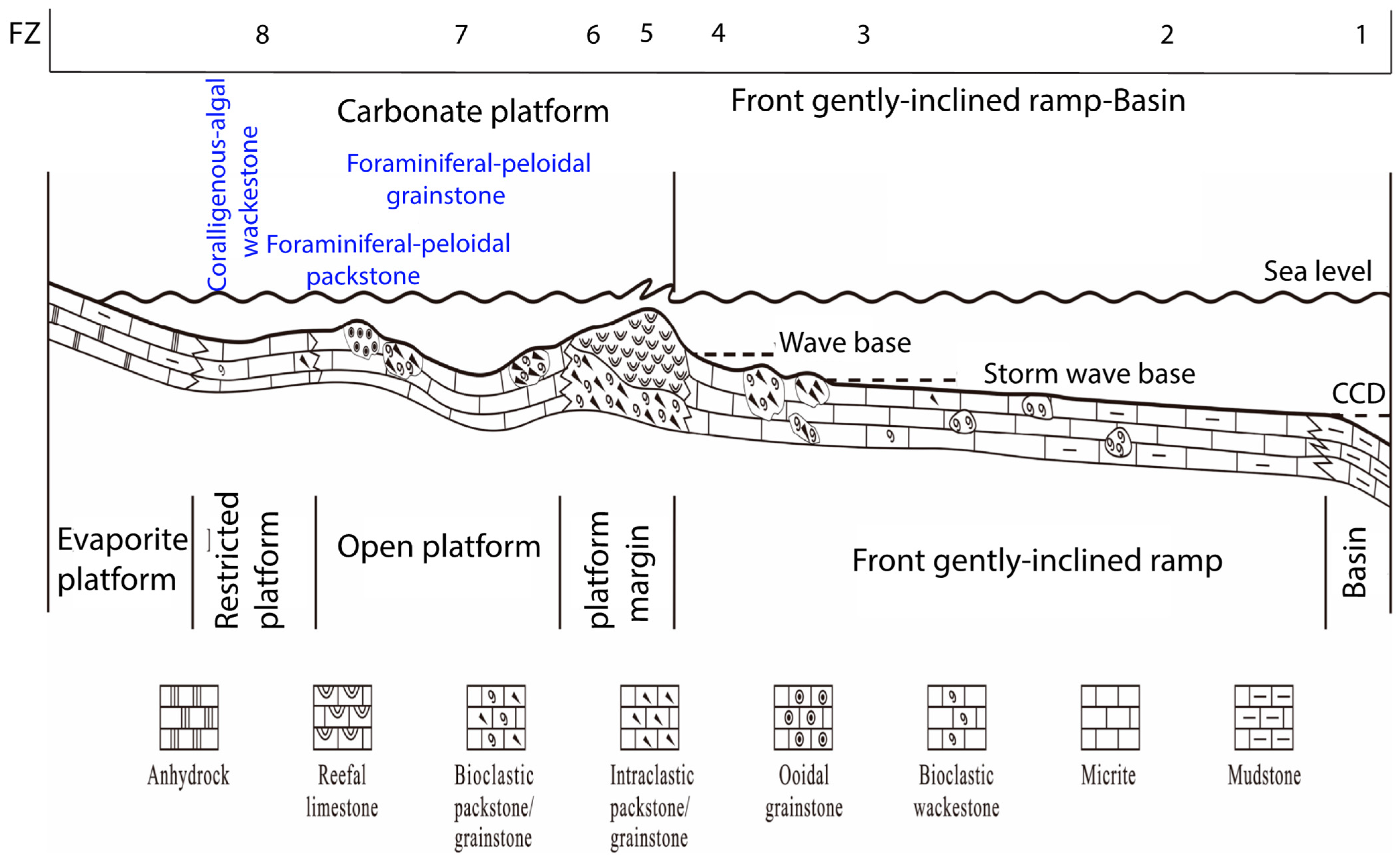
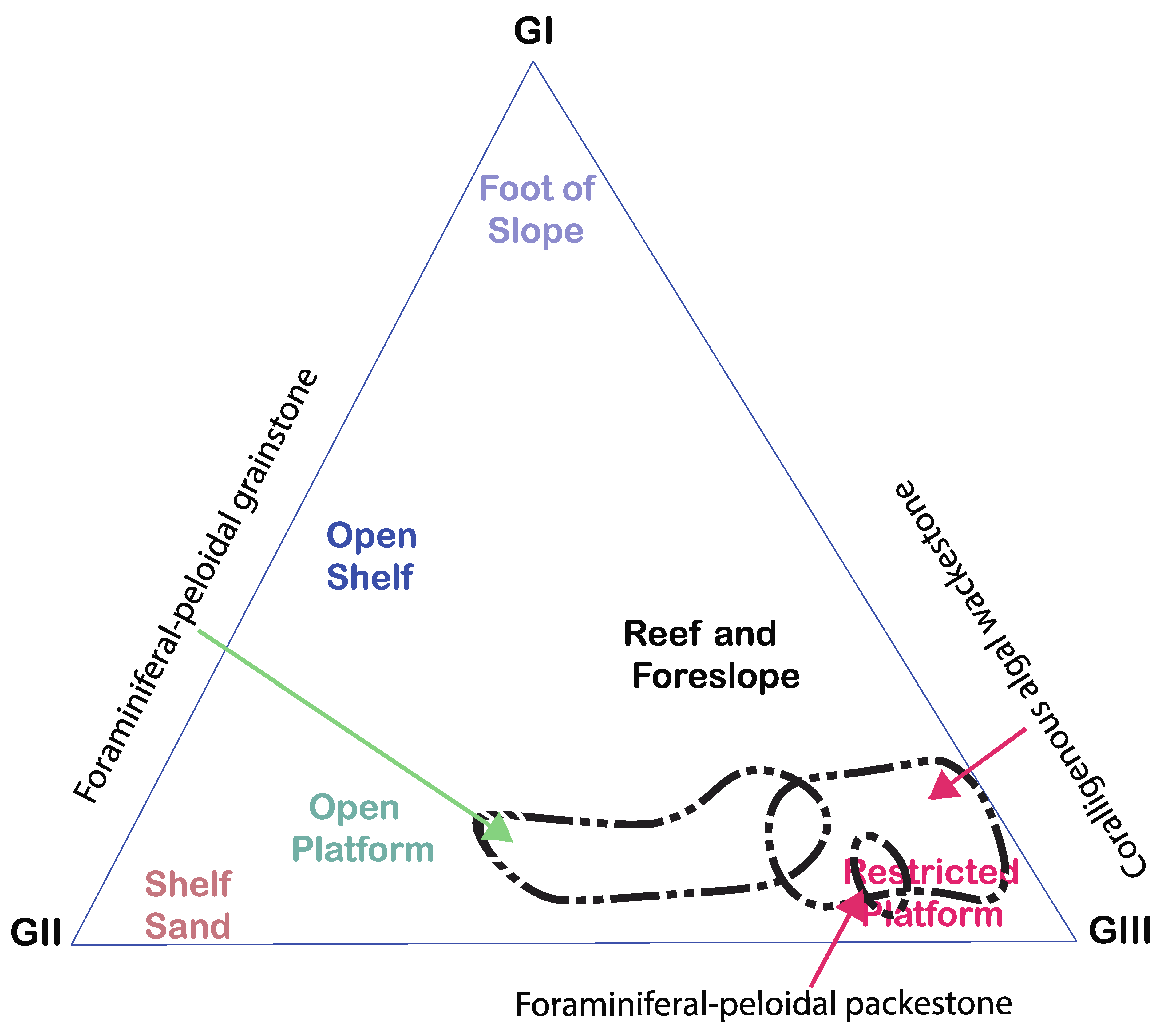
| SN | Microfacies | % of Foraminifera in Groups | ||
|---|---|---|---|---|
| GI | GII | GIII | ||
| 1 | Coralligenous–algal wackestone | 13 | 8 | 79 |
| 2 | 8 | 16 | 76 | |
| 3 | 23 | 9 | 68 | |
| 4 | 4 | 16 | 80 | |
| 5 | 6 | 8 | 86 | |
| 6 | 12 | 17 | 71 | |
| 7 | 18 | 10 | 72 | |
| 8 | 14 | 86 | ||
| 9 | 24 | 76 | ||
| 10 | 22 | 11 | 67 | |
| 11 | 23 | 7 | 70 | |
| 12 | Foraminiferal–peloidal packstone | 15 | 8 | 77 |
| 13 | 13 | 12 | 75 | |
| 14 | Foraminiferal–peloidal grainstone | 52 | 10 | 38 |
| 15 | 22 | 16 | 62 | |
| 16 | 20 | 12 | 68 | |
| 17 | 39 | 5 | 56 | |
| 18 | 22 | 10 | 68 | |
| 19 | 30 | 11 | 59 | |
| 20 | 46 | 5 | 49 | |
Disclaimer/Publisher’s Note: The statements, opinions and data contained in all publications are solely those of the individual author(s) and contributor(s) and not of MDPI and/or the editor(s). MDPI and/or the editor(s) disclaim responsibility for any injury to people or property resulting from any ideas, methods, instructions or products referred to in the content. |
© 2023 by the authors. Licensee MDPI, Basel, Switzerland. This article is an open access article distributed under the terms and conditions of the Creative Commons Attribution (CC BY) license (https://creativecommons.org/licenses/by/4.0/).
Share and Cite
Abid, A.A.; Salih, N.M.; Martyushev, D.A. Paleoenvironmental Evaluation Using an Integrated Microfacies Evidence and Triangle Model Diagram: A Case Study from Khurmala Formation, Northeastern Iraq. J. Mar. Sci. Eng. 2023, 11, 2162. https://doi.org/10.3390/jmse11112162
Abid AA, Salih NM, Martyushev DA. Paleoenvironmental Evaluation Using an Integrated Microfacies Evidence and Triangle Model Diagram: A Case Study from Khurmala Formation, Northeastern Iraq. Journal of Marine Science and Engineering. 2023; 11(11):2162. https://doi.org/10.3390/jmse11112162
Chicago/Turabian StyleAbid, Ali Ashoor, Namam Muhammed Salih, and Dmitriy A. Martyushev. 2023. "Paleoenvironmental Evaluation Using an Integrated Microfacies Evidence and Triangle Model Diagram: A Case Study from Khurmala Formation, Northeastern Iraq" Journal of Marine Science and Engineering 11, no. 11: 2162. https://doi.org/10.3390/jmse11112162
APA StyleAbid, A. A., Salih, N. M., & Martyushev, D. A. (2023). Paleoenvironmental Evaluation Using an Integrated Microfacies Evidence and Triangle Model Diagram: A Case Study from Khurmala Formation, Northeastern Iraq. Journal of Marine Science and Engineering, 11(11), 2162. https://doi.org/10.3390/jmse11112162








